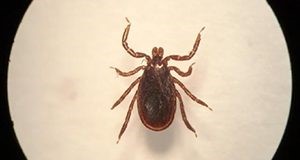Abstract
Southern tick-associated rash illness (STARI) is a human tick-borne disease that occurs following the bite of Amblyomma americanum, the lone star tick, which is the most common and aggressive human-biting tick in the South, accounting for over 90% of human tick bites in the region. STARI is often described as a “Lyme-like illness” because it causes a rash like the “bulls eye” rash associated with Lyme. Other symptoms of STARI that are similar to symptoms of Lyme disease include headache, fatigue, and muscle and joint pain. Scientists know the tick vector and that some wildlife species play a role in maintaining the disease in nature, but very little else is understood about this mysterious illness. This 4-page fact sheet provides the basic facts we do know, the differences between STARI and Lyme disease, plus advice for tick-bite sufferers and strategies to avoid tick bites. Written by Katherine Sayler, Carisa Boyce, and Samantha Wisely, and published by the Department of Wildlife Ecology and Conservation, August 2016.
References
Centers for Disease Control and Prevention. "Southern Tick-Associated Rash Illness." Accessed July 1, 2016. https://www.cdc.gov/stari/.
Colville, J. L., and D. L. Berryhill. 2007. "How to Protect Yourself against Ticks & Tick Removal Procedures," in Handbook of Zoonoses: Identification and Prevention.St. Louis, Missouri: Elsevier. 229-30. https://doi.org/10.1016/B978-0-323-04478-3.50056-7
Goddard, J., and A. S. Varela-Strokes. "Role of the Lone Star Tick, Amblyomma Americanum (L.), in Human and Animal Diseases." Veterinary Parasitology 160 (2009): 1-12. Accessed April 23rd, 2016, doi: 10.1016/j.vetpar.2008.10.089. https://doi.org/10.1016/j.vetpar.2008.10.089
Masters, E. J., C. N. Grigery, and R. W. Masters. "STARI, or Masters Disease: Lone Star Tick-vectored Lyme-like Illness." Infectious Disease Clinics of North America 22 (2008): 361-76. Accessed April 23rd, 2016, doi: 10.1016/j.idc.2007.12.010. https://doi.org/10.1016/j.idc.2007.12.010
Oliver, J. H., Jr., T. Lin, L. Gao, K. L. Clark, C. W. Banks, L. A. Durden, A. M. James, and F. W. Chandler, Jr. "An Enzootic Transmission Cycle of Lyme Borreliosis Spirochetes in the Southeastern United States." Proceedings of the National Academy of Sciences USA 100 (2003): 11642-1645. Accessed April 23rd, 2016, doi: 10.1073/pnas.1434553100. https://doi.org/10.1073/pnas.1434553100
Paddock, C. D., and M. J. Yabsley. "Ecological Havoc, the Rise of White-tailed Deer, and the Emergence of Amblyomma Americanum-associated Zoonoses in the United States," Current Topics in Microbiology and Immunology 315 (2007): 289-324. Accessed April 23rd, 2016, doi: 10.1007/978-3-540-70962-6_12. https://doi.org/10.1007/978-3-540-70962-6_12
Stromdahl, E. Y., R. M. Nadolny, J. A. Gibbons, L. D. Auckland, M. A. Vince, C. E. Elkins, M. P. Murphy, M. W. Eshoo, H. E. Carolan, C. D. Crowder, M. A. Pilgard, S. A. Hamer, and G. J. Hickling. "Borrelia burgdorferi Not Confirmed in Human Biting Amblyomma Americanum Ticks from the Southeastern United States." Journal of Clinical Microbiology 53 (2015): 1697-704. Accessed May 15, 2016. doi: 10.1128/JCM.03454-14. https://doi.org/10.1128/JCM.03454-14
Vaughn, M. F., P. D. Sloane, K. Knierim, D. Varkey, M. A. Pilgard, and B. J. Johnson. "Practice-based Research Network Partnership with CDC to Acquire Clinical Specimens to Study the Etiology of Southern Tick-associated Rash Illness (STARI)." The Journal of the American Board of Family Medicine 23 (2010): 720-27. Accessed May 2, 2016. doi: 10.3122/jabfm.2010.06.100098. https://doi.org/10.3122/jabfm.2010.06.100098

